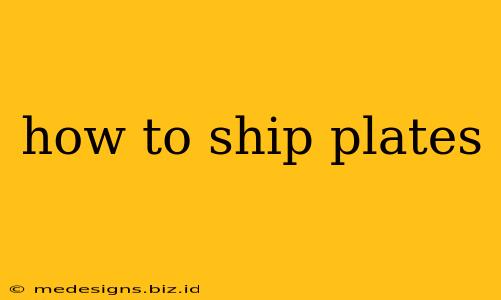Shipping plates, whether delicate china or sturdy dinnerware, requires careful planning and packing to ensure they arrive at their destination intact. This comprehensive guide will walk you through the process, minimizing the risk of breakage and maximizing the chances of a successful delivery.
Choosing the Right Packaging Materials
The key to successful plate shipping lies in using the right materials. Don't skimp on protection; it's an investment in the safety of your valuable items.
Essential Materials:
- Strong Boxes: Choose sturdy, double-walled cardboard boxes specifically designed for shipping. Avoid using flimsy boxes that can easily crush under pressure. The box should be significantly larger than your plates to allow for ample cushioning.
- Bubble Wrap: This is your best friend for protecting plates. Use generous amounts of bubble wrap to wrap each plate individually. Multiple layers are recommended, especially for fragile items.
- Packing Peanuts: These can be used in conjunction with bubble wrap to fill any remaining space in the box, preventing plates from shifting during transit. Loose-fill peanuts are better than the foam-type peanuts, as they conform better to the shape of the plates.
- Packing Paper: Use this to create additional layers of protection between plates and to fill any small gaps. Avoid using newspaper, as the ink can smudge onto your plates.
- Cardboard Inserts: These custom-fit inserts provide extra protection and prevent plates from rubbing against each other. If you're shipping a large quantity of plates, consider investing in these.
- Packing Tape: Use plenty of strong packing tape to seal the box securely. Reinforce all seams and edges to prevent the box from opening during transit.
Packing Plates for Shipment: A Step-by-Step Guide
Follow these steps to ensure your plates arrive safely:
-
Wrap Each Plate Individually: Wrap each plate generously in bubble wrap. Multiple layers are essential, especially for delicate plates. Ensure the entire plate is covered, including the edges.
-
Create a Protective Layer: Place a layer of packing paper or bubble wrap at the bottom of the box. This provides an initial cushion for the plates.
-
Arrange Plates Carefully: Place the wrapped plates in the box, standing them on their edges. Avoid stacking plates directly on top of each other. If using cardboard inserts, place them between layers of plates.
-
Fill Gaps with Packing Peanuts: Fill all empty spaces within the box with packing peanuts or crumpled packing paper. This will prevent the plates from shifting during transit and absorb any shocks.
-
Seal the Box Securely: Use plenty of strong packing tape to seal the box thoroughly. Reinforce all seams and edges to prevent the box from opening.
-
Label Clearly: Clearly label the box as "Fragile" and "Handle with Care." Include your return address and the recipient's address. Consider adding "This Side Up" arrows to prevent the box from being placed upside down.
Choosing the Right Shipping Carrier
Different shipping carriers offer varying levels of service and insurance options. Consider factors like delivery speed, cost, and insurance coverage when making your decision. Research the carrier's record for handling fragile items.
Insurance and Tracking
Always insure your shipment. This protects you financially in case the plates are damaged or lost during transit. Choose a shipping option that provides tracking, so you can monitor the package's location and delivery status.
Shipping Large Quantities or Collections
For large quantities of plates or valuable collections, consider consulting a professional packing and shipping service. They have the expertise and materials to ensure your plates arrive safely.
By following these tips, you significantly increase the chances of your plates arriving at their destination in perfect condition. Remember, proper packaging is the key to a successful shipment!
